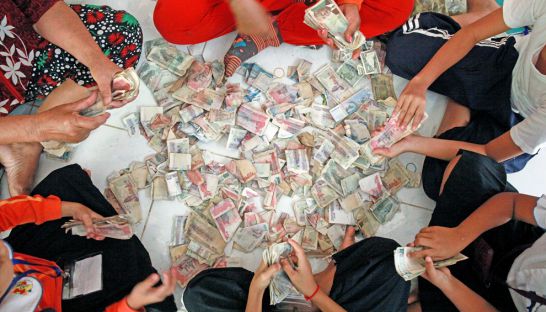NBC survey shows riel perceptions
NBC survey shows riel perceptions
The central bank released its first-ever national study yesterday on perceptions and usage of the riel and foreign currencies in Cambodia, which aimed at not only understanding existing trends, but also at steering future financial legislation to boost the circulation of Cambodia’s national currency.

The year-long study, commissioned by the National Bank of Cambodia (NBC) and undertaken by the Japan International Cooperation Agency (JICA), surveyed 856 enterprises, over 2,000 households and 15 financial institutions across the country to build a comprehensive snapshot on the usage and confidence levels of various currencies.
Khou Vuthy, director of the NBC’s economic research and international cooperation department, said that while the central bank has been injecting about 20 percent more riel into the economy annually over the last decade, the local currency’s share of the total money supply remained limited. Dollarisation remains high, at about 80 percent, though acceptance of the riel has increased substantially as the economy has deepened.
“The economy is growing faster, so the [usage] of the riel is also growing,” he said at the report’s release. “So, we are now maintaining our market share [of currency].”
While Vuthy expects that the US dollar will continue to predominate, he expressed confidence that the NBC’s monetary policies would further boost confidence in the national currency.
“I am very optimistic that Cambodian riel circulation will further grow in the future,” he said.
As widely expected, the NBC survey showed that the US dollar dominates the majority of large-scale business transactions in and around the more affluent urbanised areas of the country, including Phnom Penh and Siem Reap.
But it also showed that dollars accounted for about two-thirds of all revenue and expenditures in the poorer, rural northwestern part of the country.
Meanwhile, the areas along Vietnam and Thailand borders showed high percentages of usage of the Vietnamese dong and Thai baht, respectively, primarily due to cross-border transactions.
Overall, large enterprises dominated foreign currency usage, while the share of foreign currency diminished as it descended down the ladder to small- and medium-d enterprises in rural areas.
As for household usage, the majority of people preferred to use US dollar for loans and large transactions. However, according to one of the co-authors of the report, the riel was favoured for daily spending.
“Our survey also reaffirmed that households exchange quite frequently from US dollar to riel because they need the riel for everyday spending,” said Ken Odajima, senior research fellow of JICA. “In general household respondents are quite supportive of the usage of riel”.
Vuthy stressed that government policies aimed at promoting the riel, which include liquidity instruments such as Negotiable Certificate of Deposits (NCD), as well as requiring all taxes and public servants to be paid in riel, have helped financial institutions, and in turn consumers, to have greater confidence in the national currency.
Hiroshi Suzuki, CEO of the Business Research Institute for Cambodia, said the central bank’s pragmatic policies toward further introducing the riel into the market had created notable improvements in its usage. However, he stressed that more needed to be done if the Kingdom was going to take more control over its monetary policy, especially as the value of regional currencies fluctuates.
“Although the share of riel in Cambodia is still limited, the increasing use of riel will widen the room for the NBC’s monetary policy,” he said. “[However,] with our highly dollarised economy, the central bank cannot use their policy measures to control interest rates and money supply.”
While he said a dollarised economy has traditionally been a key advantage for the country to attract foreign direct investment because it hedges currency exchange risk, if the NBC cannot depreciate its own currency in line with regional trends like the baht, dong or Chinese renminbi, the Kingdom could lose its competitive advantage.
“Although the stability of the exchange rate between US dollar and the riel is one of the advantages, Cambodia should watch the exchange rate between US dollar and the currencies of neighbouring countries,” he said.
Jayant Menon, lead economist for Asian Development Bank’s Office for Regional Economic Integration, said that while the Kingdom’s monetary policy would benefit from de-dollarisation, the central bank should not force riel usage.
“While there will be benefits flowing from de-dollarisation, this process needs to occur naturally, and should not be forced,” he said, adding that the US dollar was needed for a transitional economy like Cambodia that is faced with a myriad of challenges.
“When these underlying challenges are addressed, then dollarisation will diminish naturally,” he said. “Until then, one needs to bear with dollarisation as a transitory phenomenon as it develops.”













